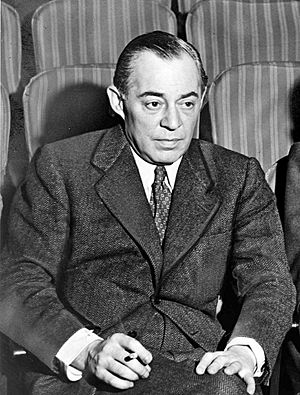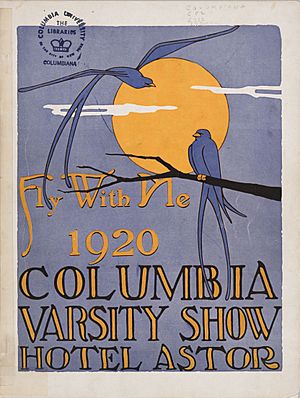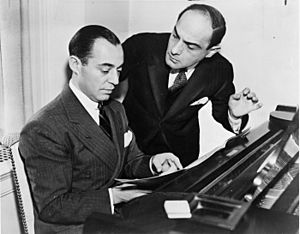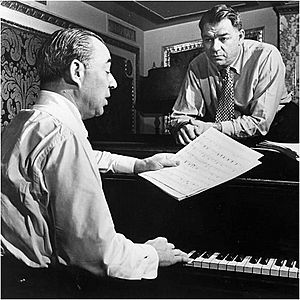Richard Rodgers facts for kids
Quick facts for kids
Richard Rodgers
|
|
|---|---|

Rodgers at the St. James Theatre in 1948
|
|
| Background information | |
| Birth name | Richard Charles Rodgers |
| Born | June 28, 1902 New York City, U.S. |
| Died | December 30, 1979 (aged 77) New York City, U.S. |
| Genres | Musical theater |
| Occupation(s) |
|
| Alma mater | Columbia University (BA) |
Richard Charles Rodgers (born June 28, 1902 – died December 30, 1979) was an American composer. He mostly wrote music for musical theater. Rodgers created 43 Broadway musicals and over 900 songs. He was one of the most famous American composers of the 1900s. His music greatly influenced popular songs.
Rodgers is well-known for working with two lyricists. First, he partnered with Lorenz Hart. Then, he worked with Oscar Hammerstein II. With Hart, he wrote musicals in the 1920s and 1930s. These included Pal Joey, A Connecticut Yankee, On Your Toes, and Babes in Arms.
With Hammerstein, he wrote musicals in the 1940s and 1950s. Some famous ones are Oklahoma!, Flower Drum Song, Carousel, South Pacific, The King and I, and The Sound of Music. His work with Hammerstein helped Broadway musicals become more serious. They told stories focused on characters and drama, not just light entertainment.
Rodgers was the first person to win all four major American entertainment awards. These are a Tony (for theater), an Oscar (for film), a Grammy (for music), and an Emmy (for television). This group of awards is now called an EGOT. He also won a Pulitzer Prize. This means he is one of only two people to win all five awards. In 1978, Rodgers was honored at the The Kennedy Center Honors for his lifetime achievements in the arts.
Biography
Early Life and Education

Richard Rodgers was born into a Jewish family in Queens, New York. His father, Dr. William Abrahams Rodgers, was a well-known doctor. Richard started playing the piano when he was six years old. He spent his early teenage summers at Camp Wigwam in Maine. There, he wrote some of his first songs.
Rodgers, Lorenz Hart, and Oscar Hammerstein II all went to Columbia University. In 1921, Rodgers moved his studies to the Institute of Musical Art, which is now the Juilliard School. Rodgers was inspired by composers like Victor Herbert and Jerome Kern. He also loved the operettas his parents took him to see on Broadway.
Career Highlights
Rodgers and Hart
In 1919, Richard met Lorenz Hart. They worked together for years in musical comedy. Their first professional song, "Any Old Place With You," was in a 1919 Broadway musical. Their first full professional show was Poor Little Ritz Girl in 1920.
Rodgers almost quit show business to sell children's underwear! But in 1925, he and Hart finally became successful. They wrote songs for a show called The Garrick Gaieties. Critics loved it. The show's biggest hit was "Manhattan". After this, they became a major songwriting team on Broadway.
For the rest of the 1920s, they wrote many hit shows for Broadway and London. These included Dearest Enemy (1925), The Girl Friend (1926), and A Connecticut Yankee (1927). Their songs from this time include "Mountain Greenery", "Blue Room", and "My Heart Stood Still".
During the Great Depression in the early 1930s, they went to Hollywood. They wrote classic songs and film scores there. These included Love Me Tonight (1932), which had "Lover" and "Isn't It Romantic?". Rodgers also wrote the music for "Blue Moon", one of their most famous songs.
In 1935, they returned to Broadway. They had a long series of hit shows until Hart's death in 1943. Some of their most famous works were Jumbo (1935), On Your Toes (1936), Babes in Arms (1937), and Pal Joey (1940). Many songs from these shows are still popular today. These include "My Romance", "Little Girl Blue", "Where or When", "My Funny Valentine", and "The Lady Is a Tramp".
Rodgers and Hammerstein
Lorenz Hart's health problems made it hard for him to work. So, Rodgers started working with Oscar Hammerstein II. They had worked together before. Their first musical, Oklahoma! (1943), was a huge success. It was a "book musical", where songs and dances are fully part of the story. This was a big change for Broadway.
The team created four more very popular musicals. All of them were made into successful films. These were Carousel (1945), South Pacific (1949), The King and I (1951), and The Sound of Music (1959). They also wrote the music for the film State Fair (1945) and a TV musical of Cinderella (1957).
Their partnership created many well-known songs. Some are "Oh, What a Beautiful Mornin'", "People Will Say We're in Love", "Oklahoma" (which became Oklahoma's state song), "You'll Never Walk Alone", "Some Enchanted Evening", "My Favorite Things", "The Sound of Music", and "Do-Re-Mi".
Rodgers also composed music for TV. He wrote twelve themes for the World War II TV show Victory at Sea (1952–53). He won an Emmy for the music for the documentary Winston Churchill: The Valiant Years.
In 1950, Rodgers and Hammerstein won the Gold Medal Award from The Hundred Year Association of New York. They also won a Pulitzer Prize for Drama for South Pacific. They had won a special Pulitzer Prize in 1944 for Oklahoma!.
Rodgers and Hammerstein musicals won many awards. They earned 37 Tony Awards, 15 Academy Awards, two Pulitzer Prizes, two Grammy Awards, and two Emmy Awards.
After Hammerstein
After Hammerstein died in 1960, Rodgers wrote both the words and music for his next Broadway show, No Strings (1962). This show was a minor hit and included the song "The Sweetest Sounds".
Rodgers also wrote new songs for the film version of The Sound of Music. He later worked with other lyricists like Stephen Sondheim and Martin Charnin.
In 1978, Rodgers was honored at the first Kennedy Center Honors. In 1979, just before he passed away, he received the Lawrence Langner Memorial Award for his lifetime achievements in American theater.
Death and Legacy
Rodgers passed away in 1979 at age 77. He had survived cancer and a heart attack.
In 1990, the 46th Street Theatre was renamed the Richard Rodgers Theatre in his honor. In 1999, Rodgers and Hart were featured on United States postage stamps. In 2002, the 100th year since Rodgers' birth was celebrated worldwide. There were books, performances, new recordings, and a Broadway revival of Oklahoma!.
Rodgers is a member of the American Theater Hall of Fame. He also started an award for new musical theater composers. This award helps them create new shows.
Personal Life
In 1930, Rodgers married Dorothy Belle Feiner. Their daughter, Mary (1931–2014), wrote the musical Once Upon a Mattress and children's books. Another daughter, Linda (1935–2015), was also a songwriter for a short time. Richard Rodgers's grandson, Adam Guettel, is also a musical theater composer. He won Tony Awards in 2005 for The Light in the Piazza.
Awards and Nominations
Rodgers is one of the few people to have won an EGOT. This means he won an Emmy, Grammy, Oscar, and Tony.
| Year | Award | Category | Title | Results | Ref. |
|---|---|---|---|---|---|
| 1944 | Pulitzer Prize Special Citations and Awards | Arts Award | Oklahoma! | Awarded | |
| 1945 | Academy Award | Best Original Song | "It Might as Well Be Spring", State Fair | Won | |
| 1950 | Pulitzer Prize | Drama | South Pacific | Won | |
| 1950 | Tony Award | Best Musical | South Pacific | Won | |
| Best Book of a Musical | Won | ||||
| Best Producer of a Musical | Won | ||||
| 1952 | Best Musical | The King and I | Won | ||
| 1956 | Pipe Dream | Nominated | |||
| 1959 | Flower Drum Song | Nominated | |||
| 1962 | No Strings | Nominated | |||
| Best Original Score | Won | ||||
| 1965 | Do I Hear a Waltz? | Nominated | |||
| 1996 | State Fair | Nominated | |||
| 1957 | Primetime Emmy Award | Best Musical Contribution for Television | Cinderella | Nominated | |
| 1961 | Outstanding Original Music for Television | Winston Churchill: The Valiant Years | Won | ||
| 1961 | Grammy Awards | Best Musical Theater Album | The Sound of Music | Won | |
| 1963 | No Strings | Won |
Shows with Music by Rodgers
Lyrics by Lorenz Hart
- One Minute Please (1917)
- Fly with Me (1920)
- Poor Little Ritz Girl (1920)
- The Melody Man (1924)
- The Garrick Gaieties (1925–26)
- Dearest Enemy (1925)
- The Girl Friend (1926)
- Peggy-Ann (1926)
- Betsy (1926)
- A Connecticut Yankee (1927)
- She's My Baby (1928)
- Present Arms (1928)
- Chee-Chee (1928)
- Spring Is Here (1929)
- Heads Up! (1929)
- Ever Green (1930)
- Simple Simon (1930)
- America's Sweetheart (1931)
- Love Me Tonight (1932)
- Jumbo (1935)
- On Your Toes (1936)
- Babes in Arms (1937)
- I'd Rather Be Right (1937)
- I Married an Angel (1938)
- The Boys from Syracuse (1938)
- Too Many Girls (1939)
- Higher and Higher (1940)
- Pal Joey (1940–41)
- By Jupiter (1942)
- Rodgers & Hart (1975), Rodgers and Hart revue musical
Lyrics by Oscar Hammerstein II
- Oklahoma! (1943)
- Carousel (1945)
- State Fair (1945) (film)
- Allegro (1947)
- South Pacific (1949)
- The King and I (1951)
- Me and Juliet (1953)
- Pipe Dream (1955)
- Cinderella (1957) (television)
- Flower Drum Song (1958)
- The Sound of Music (1959)
- A Grand Night for Singing (1993), Rodgers and Hammerstein revue musical
- State Fair (1996) (stage musical)
Other Lyricists and Solo Works
- Ghost Town (1939) (ballet)
- Victory at Sea (1952) (arrangements and orchestration by Robert Russell Bennett)
- The Valiant Years (1960)
- No Strings (1962) (lyrics also by Rodgers)
- Do I Hear a Waltz? (1965) (lyrics by Stephen Sondheim)
- Androcles and the Lion (TV) (1967) (lyrics also by Rodgers)
- Two by Two (1970) (lyrics by Martin Charnin)
- Rex (1976) (lyrics by Sheldon Harnick)
- I Remember Mama (1979) (lyrics by Martin Charnin/Raymond Jessel)
Images for kids
-
Rodgers was featured on Ed Sullivan's Toast of the Town TV show in 1952.
See also
 In Spanish: Richard Rodgers para niños
In Spanish: Richard Rodgers para niños





